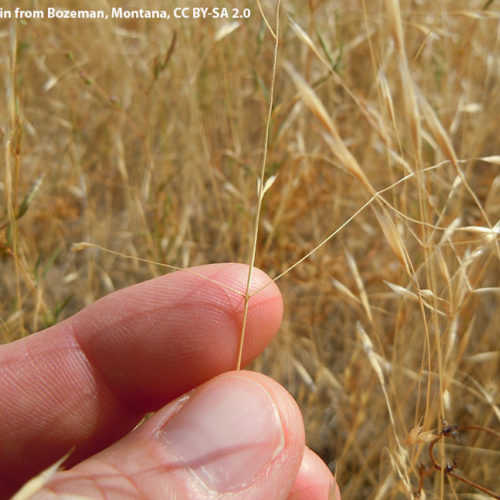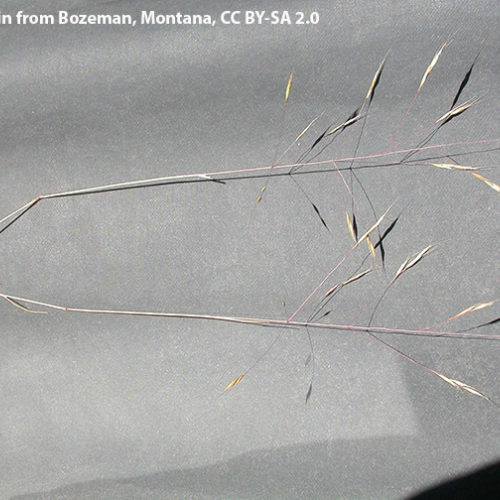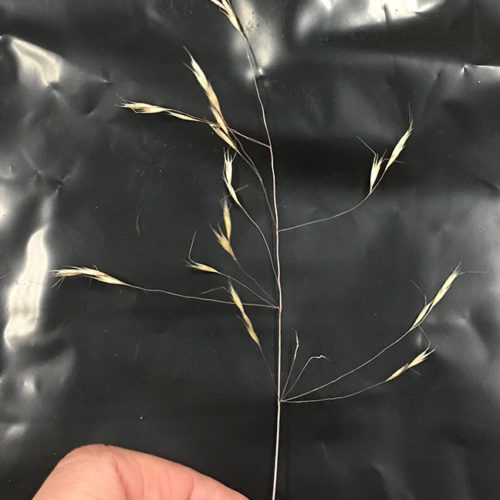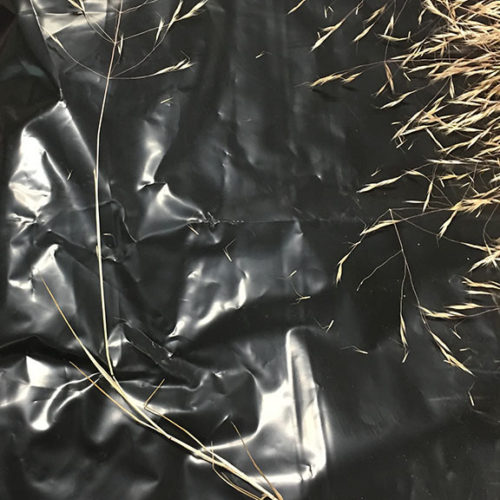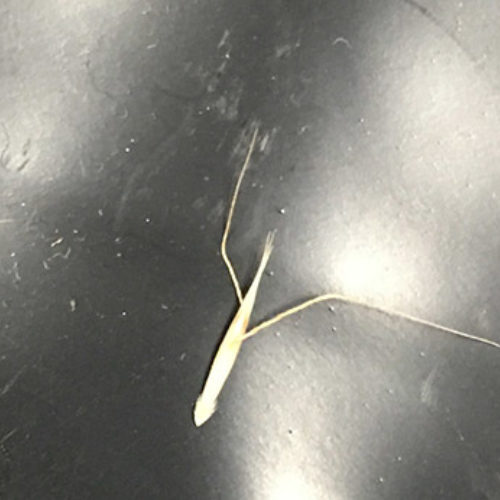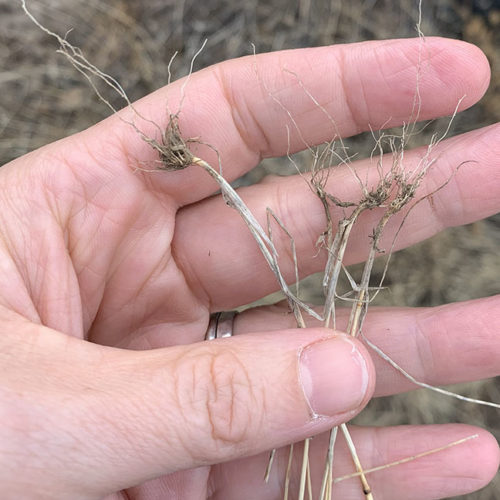Ventenata
Ventenata dubia
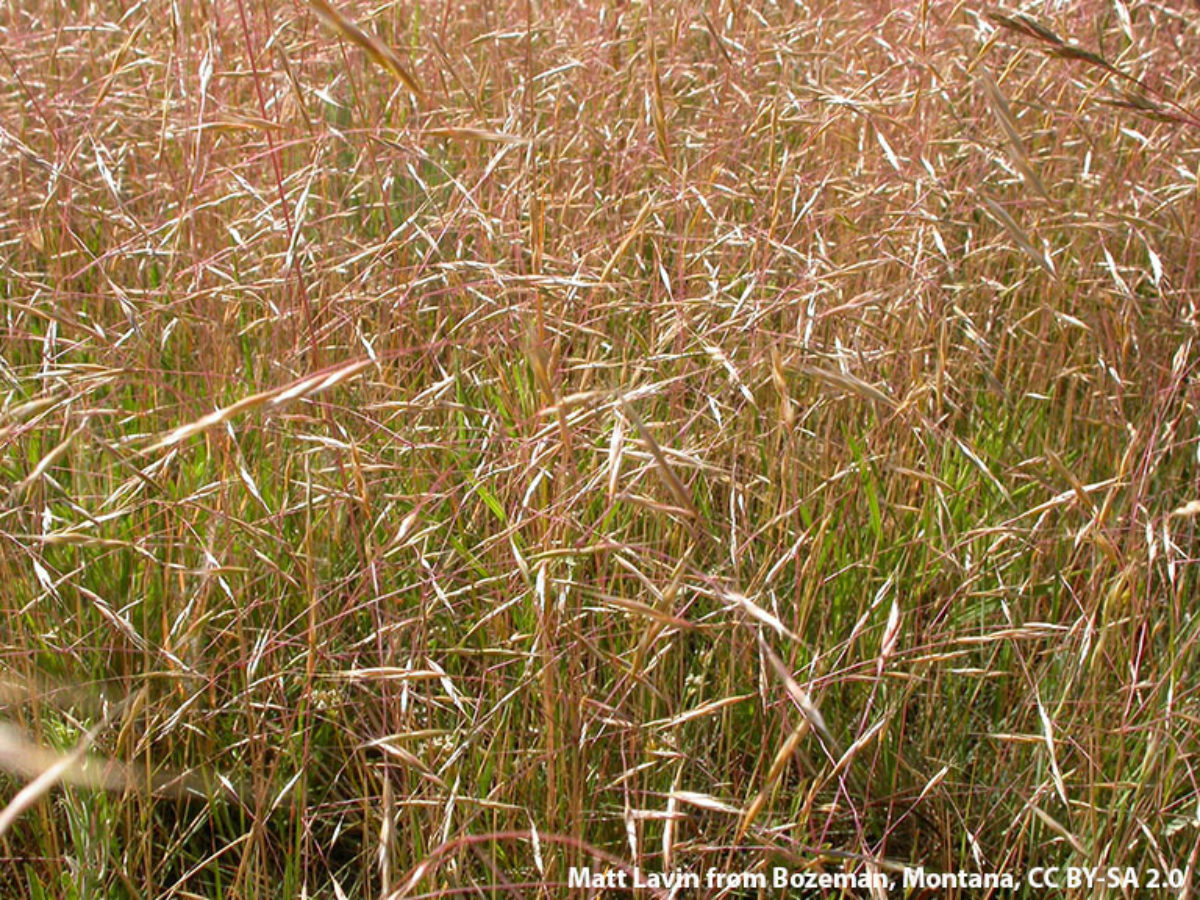
Family: Poaceae
Other Scientific Names:
Avena dubia Leers, Ventenata avenacea Koeler
Other Common Names: wiregrass, North Africa grass, ventenata, softbearded oat grass
Weed class: C
Year Listed: 2016
Native to: Europe (Central, Southwestern, Southeastern, and Eastern), Northern Africa, and temperate parts of Asia (Caucasus and Western)
Is this Weed Toxic?:
not known to be
Why Is It a Noxious Weed?
Ventenata dubia is a nonnative, invasive, annual grass that has rapidly expanded in perennial grass systems, in disturbed areas and managed areas in the past two decades throughout the Pacific Northwest. Ventenata dubia is increasingly becoming a problem in managed grass-hay systems where infestations can cause yield reductions of 50% or more within a few years. Beside hay, V. dubia can invade bluegrass, alfalfa, small grains, and other crops. Besides displacing desirable forage, Ventenata dubia contains silica (~2.7%), making it a poor forage plant where animals, including cattle, will not graze once inflorescences have formed. Ventenata dubia is also invading native Palouse Prairie, a threatened habitat in the intermountain Pacific Northwest, remnants of which are located in eastern Washington and northern Idaho. Ventenata dubia’s shallow root system may also cause soil to be prone to erosion and over time, it can lead to decline of productivity and land condition.
How would I identify it?
General Description
Ventenata is a basally branched, tufted winter annual grass that has rolled or folded leaves and membranous ligules. Openly branched panicles are pyramidal in overall shape and have spikelets comprised of typically 3 florets. The awns of some of the florets are bent and twisted. Nodes are reddish-black in late spring.
Flower Description
Ventenata dubia’s inflorescence is an open panicle, pyramidal in shape, and up to 16” long. The panicle is light yellow in color and has a sheen. Panicle branches are spreading to drooping. Spikelets on pedicels contain on average 3 florets. Because of where the spikelets disarticulate, on mature specimens the straight-awned floret remains, while the bisexual florets with bent awns have broken away
Leaf description
Ventenata dubia leaves mostly occur on the lower half of the stem and have open leaf sheaths. Leaves have glabrous, membranous ligules that are obtuse, usually lacerate (cut into narrow segments).. The leaf blades are 1 to 3 mm wide and 2 to 7 cm (occasionally to 12 cm) long, usually glabrous (smooth and hairless) on the upper surface, scabrous on the lower surface, starting out flat and becoming rolled or folded.
Stem description
V. dubia stems are slim, upright to erect, and 4 to 18 inches tall, though they can grow up to 29.5 inches (75 cm) tall. Stems can be covered in small hairs or glabrous (smooth and hairless) while the nodes are glabrous. The nodes are exposed and in late spring are purple-black.
Fruit Seed Description
The fruit is a caryopsis (a dry, one-seeded fruit) that is glabrous and about 3 mm long.
May Be Confused With
This is the only species in the genus Ventenata found in North America. Ventenata dubia can be distinguished from another weedy grass, cheatgrass also called downy brome (Bromus tectorum), which grows in similar habitats and is also an annual growing to a similar height. Characteristics that help distinguish Bromus tectorum from V. dubia are that it has straight awns and shorter ligules (1 to 3 mm).
Where does it grow?
Ventenata dubia grows in a variety of dry, open and often disturbed habitats, tending to prefer sites that are inundated in early spring but dried out by late spring. It is commonly found on south-facing hillsides with shallow, rocky clay or clay-loam soils though it can be found on other aspects and substrates. Click here to see a county level distribution map of ventenata in Washington.
How Does it Reproduce?
Ventenata is an annual grass that reproduces by seeds. Seed production is as high as 35 seeds per plant. Seeds persist in the seedbank for only a couple of years. Seed dispersal is assisted by the bent, twisted awns which "self-bury" the seeds into soil and by hay harvest, which commonly occurs when more V. dubia seeds are present.
How Do I Control It?
General Information
Ventenata dubia can be difficult to control, and an integrated approach will be needed for effective control and to promote and support healthy communities. It is important to prevent spreading Ventenata dubia to new locations. When working around V. dubia, make sure to clean equipment and clothing to prevent dispersing seed to new locations. Due to at least some V. dubia seed surviving in the seedbank up to 3 years, at least 3 to 4 years of intensive integrated management methods will be needed to reduce effects on grass systems. It is important to prevent V. dubia seed production. Soil disturbance may cause more seeds to germinate so monitoring and follow up management may be needed. Establishing and promoting diverse, healthy plant communities will provide competition to V. dubia and help reduce infestations.
Manual/Mechanical Control
Hand pulling plants when the soil is moist is a possibility but only where infestations are small (generally < couple square yards), as hand-pulling is labor intensive. Mowing in some cases may help to prevent V. dubia seed production. It is reported that V. dubia cannot be mowed during heading as plants will only bend or become tangle in equipment. Plants that are mowed prior to heading may produce another flush of inflorescences, so mowing multiple times throughout the growing season will be needed to prevent seed production. Targeted mowing in CRP and harvesting hay for silage before V. dubia seed production are options that are being tried. Harvesting hay early, before V. dubia develops seed, is possible, but unstable weather during June makes early harvest risky. Ventenata dubia stems are difficult to cut and need sharpened equipment and slow mow speeds.
Cultural Control
Fire, combined with other management methods, may help control Ventenata dubia infestations. Burning the litter of Ventenata dubia, which protects and aids its seedlings, can help reduce V. dubia germination and survivorship. Ventenata dubia has been found to flourish in Oregon following fire, though in Idaho, fire did suppress V. dubia, but did stimulate annual weedy bromes. Fire, while a useful tool, cannot be used alone to control V. dubia, as it may provide an environment that could encourage seed germination. Fire can also clear and prep a site for an herbicide application of post fire emerging nonnative species. Integrating the use of fire with herbicide treatments and seeding of competitive species will help prevent the further germination of V. dubia. Incorporating the planting and seeding of competitive native and non-invasive plants will provide competition to Ventenata dubia seedlings. Some species that have been planted to provide competition to V. dubia include Idaho fescue (Festuca idahoensis), bluebunch wheatgrass (Pseudoroegneria spicata), Sandberg bluegrass (Poa secunda), ‘Sherman’ big bluegrass (Poa secunda ‘Sherman’) intermediate wheatgrass (Thinopyrum intermedium), smooth brome, grassy tarweed (Madia gracilis), and clarkia (Clarkia pulchella).
Biological Control
There are no approved biological control agents for Ventenata dubia. Grazing does not seem a likely or reliable management tool since animals tend to avoid plants, especially when V. dubia matures. Grazing could be used for site preparation in mixed stands where V. dubia is a small component of the plant community. Grazing in summer or fall of co-occurring plant species can remove plant biomass in order to increase the amount of herbicide contact on V. dubia seedlings that emerge in the fall.
Herbicide Control
Herbicide information on Ventenata dubia is available in The Pacific Northwest Weed Management Handbook and includes information on rates and timing. See DiTomaso et al. (2013) for additional herbicide recommendations. In general, late fall herbicide applications just after seedlings emerge are the most effective for controlling invasive winter annual grasses, but changing weather conditions may make treatment difficult. Overall, herbicide should be used with other management methods to control Ventenata dubia. Using other methods such as fire and providing competition by seeding other plant species will be needed to successful control V. dubia infestations. Always read and follow the herbicide label instructions. Check with your local county noxious weed coordinator to discuss treatment options.
For More Information
See our written findings on ventenata.
Ventenata control strategies found for forage producers, University of ID Extension
USDA Forest Service's Fire Effects Information System (FEIS) Summary of Ventenata dubia



